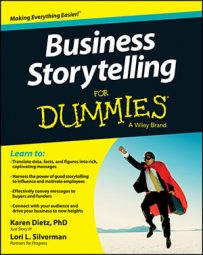Characters are very important when you want to engage listeners in your story. To add more zing to a story, detail some of the characteristics and motivations of your characters using lots of sensory information (LOTS). Before you do so, determine where it’s important for you to provide these details to listeners. The following questions can help:
What are the distinguishing features and distinctive gestures of your characters? These could be talents and abilities. Find ways to add these details in where needed.
How can you bring additional dialogue into the story to increase connection and empathy for the characters? Go through each paragraph and ask whether it would add value to turn it into dialogue.
What speaking style do your characters use? Are they talkative, taciturn, soft-spoken, loud, formal, casual, fast, slow, or have accents? Determine how you can bring out these speaking styles if the story is in print or electronic form (or act this out if you’re telling the story).
What is the main character’s short-term goals and long-term needs? Consider whether you need to add in these pieces for some or all of the supporting characters.
What fears do your characters have? Tell us about them and the growth they achieve by the end of the story.
If your story is about a group, let listeners know which group member is the main character; some are secondary characters — they help the main character to move the story along. The rest will be minor characters who may not even have a role. Give the main character and the secondary characters a name and differing characteristics. Minor characters don’t need to be named.
To convey a better picture of the little girl in the mind’s eye, what if the story went like this:
The little girl was wearing a short sleeve white shirt with flowers on it and a pair of hot pink shorts. Her sandy blond hair was in pigtails. As she wailed, a river of tears streamed from her puffy green eyes.
Why would you add this level of detail to the little girl versus any other character? Because she has so little dialogue in the story, this allows you to identify more strongly with her.
Let’s go on to dialogue. Where would additional external and/or internal dialogue benefit the story? Consider this paragraph towards the end:
She explained to me that her daughter had been taken from her and that she’d been without her daughter for some period of time and had been searching for her. She was just getting her back and was scared. She really, really appreciated that I’d tried to understand and help. It made a difference to her.
You could re-craft this text into character dialogue to strengthen the ending.
“You see . . . I haven’t seen my daughter in quite some time. She was taken from me and I’m just getting her back. I’ve been looking for her for a long time. I was so scared that I’d never see her again. I really, really appreciate your understanding and your help. It’s made a big difference.
This dialogue may come from the story transcript or from clarifying questions asked to the originator of the story. If dialogue is needed, and the originator doesn’t recall it specifically, ask them to recall the nature of the conversation. Dialogue only needs to do reflect the exact words that were said when they are of critical importance to the story or the originator of the story.
Now go back to your story. How can you bring your characters to life?

